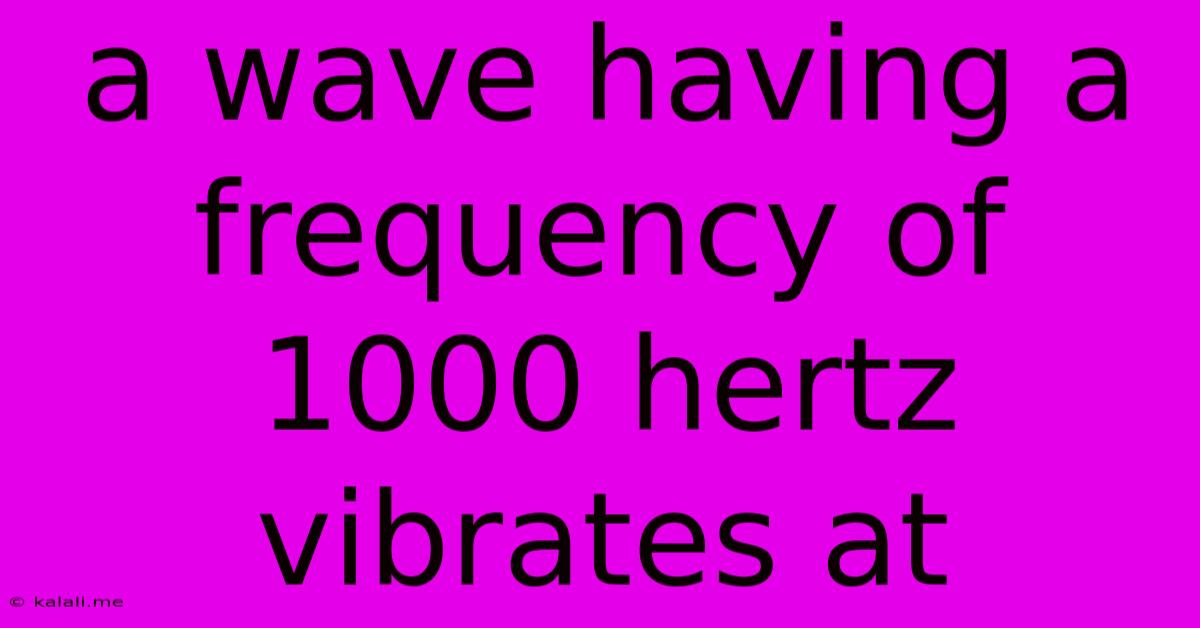A Wave Having A Frequency Of 1000 Hertz Vibrates At
Kalali
Jun 15, 2025 · 3 min read

Table of Contents
A Wave Having a Frequency of 1000 Hertz Vibrates At... A Deep Dive into Frequency and Wavelength
A wave with a frequency of 1000 Hertz (Hz) vibrates 1000 times per second. This seemingly simple statement opens the door to a fascinating exploration of wave properties, their relationship to each other, and the implications across various fields like sound, light, and even seismology. This article will delve into what this means, exploring the connection between frequency, wavelength, and the speed of the wave.
Understanding Frequency and its Implications
Frequency, measured in Hertz (Hz), represents the number of complete oscillations or cycles a wave completes in one second. A 1000 Hz wave, therefore, undergoes 1000 complete cycles of oscillation every second. This is a relatively high frequency, placing it well within the audible range for humans (typically 20 Hz to 20,000 Hz). Higher frequencies translate to a higher pitch in sound waves, and higher energy levels in other types of waves.
The Role of Wavelength
The relationship between frequency and wavelength is crucial to understanding wave behavior. Wavelength (λ, lambda) is the distance between two consecutive crests (or troughs) of a wave. The speed of a wave (v) is directly related to both frequency (f) and wavelength (λ) by the following equation:
v = fλ
This means that the speed of the wave is equal to the product of its frequency and wavelength. To determine the wavelength of a 1000 Hz wave, we need to know the speed of the wave. The speed varies depending on the medium through which the wave travels.
Wave Speed and Medium Dependency
-
Sound Waves: The speed of sound in air is approximately 343 meters per second (m/s) at room temperature. Using the equation above, the wavelength (λ) of a 1000 Hz sound wave in air would be:
λ = v/f = 343 m/s / 1000 Hz = 0.343 meters -
Light Waves: The speed of light in a vacuum is approximately 3 x 10^8 meters per second (m/s). A 1000 Hz wave in the electromagnetic spectrum would be a very low-frequency radio wave. Its wavelength would be significantly longer than that of a sound wave:
λ = v/f = 3 x 10^8 m/s / 1000 Hz = 3 x 10^5 meters(300 kilometers)
Applications and Further Considerations
The concept of frequency and its relationship to wavelength has extensive applications across diverse fields:
-
Audio Engineering: Understanding frequencies is vital in designing audio equipment, equalizers, and sound systems. The 1000 Hz frequency falls within a range crucial for speech intelligibility.
-
Medical Imaging: Ultrasound uses high-frequency sound waves to create images of internal organs.
-
Communications: Radio waves, with their varying frequencies, form the basis of wireless communication technologies.
-
Seismology: Seismic waves, generated by earthquakes, have different frequencies that provide information about the Earth's interior.
It's important to remember that the speed of a wave, and therefore its wavelength at a given frequency, is heavily dependent on the medium it travels through. The examples above illustrate this point, highlighting the dramatic differences between sound and light waves. Understanding these fundamental concepts provides a solid foundation for exploring the fascinating world of wave phenomena.
Latest Posts
Latest Posts
-
What Is The Value Of 1 4
Jun 16, 2025
-
Which Of The Following Attack Compromises Confidentiality Choose Two Options
Jun 16, 2025
-
According To The Law Of Supply When Prices Increases
Jun 16, 2025
-
How Many Diagonals Does A Nonagon Have
Jun 16, 2025
-
Lcm Of 2 And 3 And 6
Jun 16, 2025
Related Post
Thank you for visiting our website which covers about A Wave Having A Frequency Of 1000 Hertz Vibrates At . We hope the information provided has been useful to you. Feel free to contact us if you have any questions or need further assistance. See you next time and don't miss to bookmark.